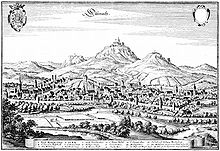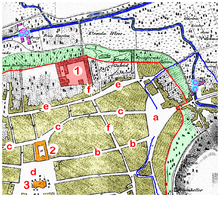Wasserburg clamp
| Wasserburg clamp | ||
|---|---|---|
|
Sketch of Klemme Castle (around 1800) |
||
| Alternative name (s): | Niederburg | |
| Creation time : | before 1250 | |
| Castle type : | Niederungsburg | |
| Conservation status: | desolate | |
| Standing position : | Landgraves | |
| Place: | Eisenach | |
| Geographical location | 50 ° 58 '38.3 " N , 10 ° 19' 21.1" E | |
| Height: | 218 m above sea level NN | |
|
|
||
The moated castle Klemme is a lost moated castle in the old town of Eisenach that existed for a period of about 600 years. It was a fortress , later an official seat and hunting arsenal, and finally a garrison .
history
Construction as a fortress against the citizens of Eisenach
Under the pavement and the adjoining buildings of the Eisenacher Theaterplatz one can occasionally come across the last traces of a Niederungsburg built in the middle of the 13th century on the northern edge of Eisenach's old town, which in the older traditions as sloß ysenach or castrum Clemme , later shortened to Cley , Klei or Terminal is referred to. As the builder of the original fortification, Sophie von Brabant or her opponent, Margrave Heinrich von Meißen , were contradictingly handed down in the chronicles, the original purpose remained undisputed: the castle as a military complex was always an open threat and a symbol of power towards the Eisenach townspeople. Inserted into the north side of the city fortifications, this bridgehead enabled a separate entrance into the city, at the same time the castle controlled all roads leading into the city from the north and, if necessary, could enter the city in cooperation with the Wartburg (responsible for the south- facing roads) get in a tight spot. This fact quickly became the castle's preferred nickname and was retained by the Eisenach chroniclers. The Eisenach city chronicler Johannes Rothe reports in connection with the Wettin house war, ... at that time the citizens of Eisenach bought the Clemda in 1306 and destroyed it as a hated symbol of foreign rule ... The area adjacent to the city was allowed to keep a clear field of fire the castle within archery range are not built on. This inner-city area, which is also highly prone to flooding, was only settled in the 18th century with the establishment of Sophienstrasse.
Landgrave's official seat
As a result of the lost war, rebuilt by the defeated Eisenach citizens from 1308 as a penance, the complex soon also served as an official seat of the developing Wettin administrative apparatus. The occupation of the castle was provided by the landed gentry in the 14th century, the names of the castle men and bailiffs are: Wetzel von Stein , Hermann von Buchenau , Dietrich von Witzleben , Johann Trott , a knight Schindekop. However, they did not have the right to live in the castle and used castle estates located in the city and in the villages . In 1440 Fritz von Frimar and Heinrich von Bischofsrode are also mentioned , who then also lived in the castle. The Clemda office comprised a stock of places and rights that was to be addressed as a free float, which was predominantly in the northern area around Eisenach.
City jail
In 1502, the Eisenach city council acquired the already dilapidated tower and adjacent parts of the castle in order to be able to use them as an additional city prison. During the Peasants' War in 1525 the imprisoned leaders of the Werrahaufen were incarcerated in the Klemme and other secure locations in Eisenach, and they were executed on May 10, 1525 on the market square. In the late 16th century, Kaspar and Johann Ernst von Teutleben sat in the castle as castle men, who later got into a violent dispute with the Eisenach city council and the church authorities because they exiled supporters of the Jena theologian Matthias Flacius to an asylum in the walls of the castle granted. In 1609 the von Teutleben family acquired the already dilapidated Klemme Castle and the ruins of the monastery in the Johannistal .
Hunting and armory
After further changes of ownership, Duke Johann Ernst bought back the clamp, because he needed the property as a building site for a planned pleasure and hunting palace, in this context the racecourse (for horse races) and the Clemdagarten were built directly in front of the city moat, this was a baroque park and Pleasure garden . However, the construction work was still limited to the bare essentials, the Eisenach cityscape from Merian, dated around 1650, still shows the terminal as a medieval-style fortification with towers and walls.
Manor, stables and municipal criminal investigation department
In 1641 the terminal was given as a gift to the Duchess Dorothea , wife of Duke Johann Georg I of Eisenach , who was a practical woman and had a model farm set up in the terminal. In the famine years of the Thirty Years' War , the Duchess supported the starving Eisenach townspeople from the natural produce. From her the subsequent Duke Adolf Wilhelm acquired the clamp as a stables . After the end of the Eisenach dukes, the city administration also took over the remaining buildings and expanded the prison again. At the same time, the system was further softened and the moats were gradually filled in.
Barracks and garrison
The former Zwingburg experienced its last conversion when the Grand Duke of Saxony-Weimar-Eisenach had the building converted into the first Eisenach barracks , the Eisenach garrison only existed at this location until 1870, the vacant terminal was meanwhile taken over by the Eisenach patron Baron Julius von Eichel-Streiber was acquired, the building was torn down and, from 1878, the Eisenach theater was built on the same site .
Structural matters
The moated castle had an area of about 150 by 100 m. There were gates secured access to the city and to the northern apron of the city. The castle had a fort-like structure and at least one tower. The northern city wall began at the east and west walls of the terminal. The battlements but the tradition was to not interconnected. The moat of the castle was part of the city fortifications and was filled by the Hörsel and groundwater.
In the adjacent (revised) excerpt from an Eisenach city map from the 19th century, the terminal is still present as a building complex, in the plan mean: (1) The Eisenach garrison, previously Klemme Castle, (2) the city palace, (3) St. Georgen, (a) Karlsplatz (Sonnabensmarkt), (b) Karlstraße (Judengasse), (c) Alexanderstraße (Untergasse), (d) Markt (Wednesday market), (e) Sophienstraße (Kleiner and Großer Ackerhof), (f) Querstraße (Salzgasse) .
literature
- Hermann Helmboldt: The castle clamp and the Clemda in Eisenach . In: Max Kürschner (Hrsg.): Heimatblätter for the Eisenach district . tape 9 , issue 1-2. Max Hense printing and publishing house, Eisenach 1943, p. 51-56 .
- Ulrich Nikolai: From the fortress to the barracks. Once a moated castle, today a theater square - the Clemda moated castle . In: Eisenacher Tagespost (Ed.): The Wartburgland . Number 4. Eisenacher Tagespost, Eisenach 1934.
- Constanze Lang Maß: The Eisenach city fortifications . In: Eisenacher Geschichtsverein (ed.): Writings of the Eisenacher Geschichtsverein . Eisenach 1995, ISBN 3-9803976-2-9 , pp. 104 .
- Dieter Zeigert: Military buildings in Thuringia. A catalog of the barracks buildings with a detailed description of the military-historical circumstances in Thuringia since the German military constitution of 1821 . Ed .: Thuringian State Office for Monument Preservation and Archeology. Verlag Bildung + Wissen, Bad Homburg / Leipzig 1997, ISBN 3-927879-94-0 , p. 69-74 .



